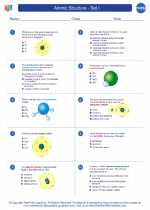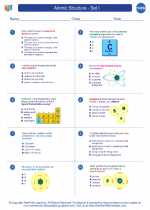Atomic Structure - Set I -> atoms
Atoms
Atoms are the basic building blocks of matter. Everything around us, from the air we breathe to the food we eat, is made up of atoms. Atoms are incredibly small - so small that they cannot be seen with the naked eye. In fact, a single drop of water contains more than a billion billion atoms!
Structure of an Atom
Atoms are composed of three subatomic particles: protons, neutrons, and electrons.
- Protons: Positively charged particles found in the nucleus of an atom.
- Neutrons: Neutral particles found in the nucleus of an atom.
- Electrons: Negatively charged particles that orbit the nucleus in specific energy levels.
The number of protons in the nucleus determines the element's identity. For example, an atom with 6 protons is carbon, while an atom with 8 protons is oxygen.
Atomic Number and Mass Number
The atomic number of an element is equal to the number of protons in the nucleus. It is represented by the letter Z. The mass number of an element is the sum of the number of protons and neutrons in the nucleus. It is represented by the letter A.
The number of neutrons in an atom can be calculated by subtracting the atomic number from the mass number (neutrons = mass number - atomic number).
Isotopes
Isotopes are atoms of the same element that have the same number of protons but different numbers of neutrons. This means they have the same atomic number but different mass numbers. For example, carbon-12 and carbon-14 are isotopes of carbon, with 6 protons each but 6 and 8 neutrons, respectively.
Electron Configuration
Electrons are arranged in specific energy levels or shells around the nucleus. The first shell can hold up to 2 electrons, while the second and third shells can hold up to 8 electrons each. The arrangement of electrons in an atom is called its electron configuration.
Study Guide
To study atoms effectively, consider the following key points:
- Understand the structure of an atom, including the roles of protons, neutrons, and electrons.
- Know how to calculate the number of protons, neutrons, and electrons in an atom.
- Learn to determine the atomic number and mass number of an element from its symbol.
- Be able to identify isotopes and differentiate between them.
- Master the concept of electron configuration and how electrons are arranged in an atom.
By mastering these concepts, you will have a solid understanding of atoms and their fundamental properties.
[Atoms] Related Worksheets and Study Guides:
.◂Chemistry Worksheets and Study Guides High School. Atomic Structure - Set I

 Worksheet/Answer key
Worksheet/Answer key
 Worksheet/Answer key
Worksheet/Answer key
